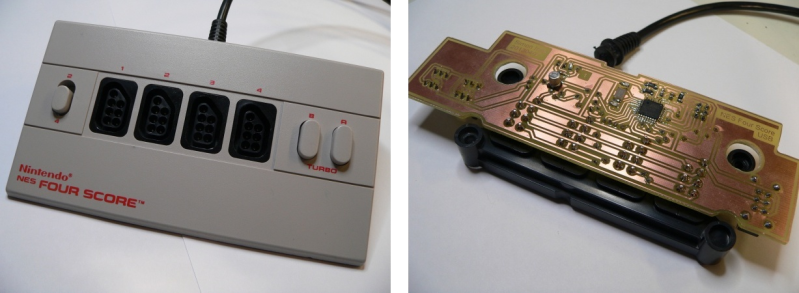The Nintendo Four Score was a controller attachment for the original Nintendo Entertainment System which allowed you to use four controllers at one time. [Simon Inns] wanted to use some original NES controllers on his computer so he developed a drop-in replacement board that converts the device to USB.
As we’ve seen with other NES controller hacks, the hardware uses a simple parallel to serial shift register to deliver key-presses to the console. This means that reading four controllers at a time is no different than shifting in data to a microcontroller from the four different sources. The remaining portion of the problem is providing a USB connection that enumerates the device as a joystick. We’ve seen a bunch of USB projects from [Simon] so it’s no surprise that he was able to pull it off.
He went with the ATmega16U2 which has built-in support for USB. [Simon] wrote the code so that although there is only one USB cable, each of the four controller ports will appear as a separate USB joystick on the computer. To button up the project he carefully measured the original board and laid out his own version so that it fits the footprint of all the original components as well as the mounting brackets on the case. Top notch [Simon]!
















Don’t know why he reinvented the wheel by writing his own code… Raphnet did this with a cheaper Atmega8 a few years back http://www.raphnet.net/electronique/4nes4snes/index_en.php
Because of the overload of information now on the net, sometimes the wheel is often recreated just because they don’t know someone did it already. That, or he thought he could do it better, or hey EVEN better, he wanted to learn it instead of copy it.
“sometimes the wheel is often recreated just because they don’t know someone did it already”
I really wish someone would create a database index of the internet and allow you to search it. If I made one I would call it google..
Honestly, he did not research his project much, searching for “snes USB” turns up thousands and thousands of results.
the #1 thing all the newbie “hackers” need to learn is how to do research, google does give classes on how to use their search engine… problem is you have to search for them..
What on earth makes you think he didn’t research rather than just wanting to make something for hims-oh it’s fartface
Often the wheel is intentionally re-created. It can be a vital part of the learning process and can be an efficient way to learn several systems at once. It’s not quick, but it can be thorough and rewarding.
There are a few reasons I didn’t use the ATmega8; V-USB is not electrically compliant to the USB standard and requires more components, an ATmega16u2 allows you to use LUFA which is very flexible and (mainly) I happen to have a lot of ATmega16u2s to hand. Besides the ATmega16u2 is actually cheaper than the ATmega8 from my local supplier (RS components) and more powerful.
I one several years ago (based on the 4nes4snes, though I had to add fourscore support) that works by connecting a small second board to the existing PCB – it can be built on perfboard easily.
http://www.flickr.com/photos/ryanqx/3179257204/in/set-72157612311936830/
Er, “I made one” – I seem to have accidentally a word there.
Looks like the link to the earlier project (second link in the post) is down or has moved somewhere else. Is there a mirror available?
You could use this: http://web.archive.org/web/20110823154759/http://oldibmpc.sitesled.com/nestoxt/
However the videos at the bottom of the page are missing.
The first video is the same as the one embeded in the HaD article itself, the second one is quite dissoriented and only shows how the adapter returns values of the different keypresses (without any speech or explanation). I will try to make a new video sometime this summer where I demonstrate the latest model which is shown on the (now dead but archived) webpage.
I really should try to find a proper host at some point. SiteSled was doomed from the start, but it was free (and best of all; ad-free). I do have a backup of the entire webpage offline, so it would be quite easy to restore it if I only found a host. It will problably not happen too soon, but eventually…
I have build the Adapter from Raphnet, buit i have problems with the four score.
Has anyone else a problem?
The first 2 Controllers fork fine. But when i switch to 4 it sets all Buttons from controller 3 and 4 on controller 1 and 2. The Dpads 1,2 works, 3,4 not.
http://www.raphnet.net/electronique/4nes4snes/index_en.php